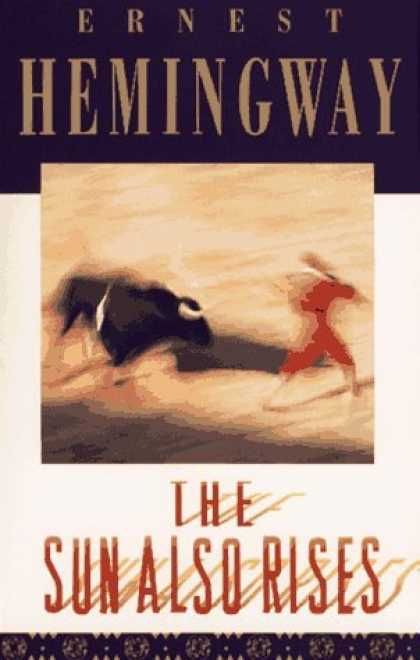
It was Gertrude Stein who coined the famous phrase “lost generation” to describe the unlucky men and women who came of age during the cataclysm of the First World War, but it was Hemingway who made it famous, using it as an epigraph for his first novel, The Sun Also Rises. How would you behave if you found yourself a survivor of the apocalypse? Surely you would not pick up where you left off, carrying on the same traditions, professing belief in the same gods. You would be marked, irrevocably scarred, and probably eager for a stiff drink. The setting of Hemingway’s debut novel is Paris in the 1920s, but none of his major protagonists are Parisian, or even French. They are all expatriates, living off of familial wealth, or else working just enough to keep themselves in drink. There are no long-term plans or commitments made, for the simple reason that none of these characters have any faith in the future, and so every day life begins anew, and life itself is reduced to a succession of days – which brings us to the book’s second epigraph, from Ecclesiastes: “One generation passeth away, and another generation cometh; but the earth abideth forever … The sun also ariseth, and the sun goeth down, and hasteth to the place where he arose …”
Our three principle characters are Robert Cohn, a wealthy American, former Princeton college boxing champion, and something of an insecure neurotic, accustomed to being excluded and made fun of for being Jewish; Lady Brett Ashley, a twice-divorced British aristocrat whose beauty and numerous sexual affairs make her an object of every male character’s desire and occasional derangement; and Jake Barnes, Hemingway’s closest stand-in, and certainly the character he most wants us to sympathize with: an American journalist made impotent by a war wound, and driven to the point of despair by his love for Lady Ashley, reciprocated but unconsummated. Each of them has arrived in Paris more in the spirit of escape than pursuit, and most of the novel’s early scenes involve hard drinking and bar hopping, with Lady Ashley at the center of various romantic longings (“When I think of the hell I’ve put chaps through”). No one suffers more from affection for her than Jake Barnes, but it’s a pain he keeps to himself, even when his male friends express interest in her. The situation, in other words, tortures him:
I never used to realize it, I guess. I try and play it along and just not make trouble for people. Probably I never would have had any trouble if I hadn’t run into Brett when they shipped me to England. I suppose she only wanted what she couldn’t have. Well, people were that way. To hell with people. The Catholic Church had an awfully good way of handing all that. Good advice, anyway. Not to think about it. Oh, it was swell advice. Try and take it sometime. Try and take it.
These thoughts, coming to him in the unguarded hours of the night, bring Barnes to tears, and not for the last time in the novel. “It is awfully easy to be hard-boiled about everything in the daytime, but at night is another thing.” We do not envision Hemingway heroes being ineffective, impotent and emotional, but Barnes nonetheless wins our sympathies, and because of his failings, not in spite of them.
The novel takes an abrupt turn when the group of unlikely expats head for Pamplona, to watch the running of the bulls and take in the bull fights, and here we get a contrasting vision of masculinity, or of life in the post-war world. The matadors – particularly the teenage prodigy, Romero – are simultaneously artists and warriors, making sport out of their fearless confrontation with the bulls. If the bloodless Europeans are all exhausted, incapable of facing their lives head on, or without the lubrication of alcohol, then the matadors are courageous fighters, staring death literally head on, and triumphing over their fears. Here is Hemingway’s description of Romero’s technique:
Romero never made any contortions, always it was straight and pure and natural in line. The others twisted themselves like cork-screws, their elbows raised, and leaned agains the flanks of the bull after his horns had passed, to give a faked look of danger. Afterward, all that was faked turned bad and gave an unpleasant feeling. Romero’s bull-fighting gave real emotion, because he kept the absolute purity of line in his movements and always quietly and calmly let the horns pass him close each time. He did not have to emphasize their closeness. Brett saw how something that was beautiful done close to the bull was ridiculous if it were done a little way off.
To keep a straight line, without contorting, it so maximally expose yourself to the danger of the bull and his horns, and the beauty Brett sees in his art translates into a sexual attraction that she pursues – to the shame of all the men in love with her. Given a choice between drunk wastrels exhausted by life, and the vigorous, fearless matador, who could blame her?
I first read The Sun Also Rises as a high school student, and much of it surely went over my head. Now I am around the age of the novel’s protagonists, trapped in a generation every bit as lost and led astray as Hemingway’s, and it seems to me a picture-perfect representation of men and women wasting their lives, while seeing no alternative. It is, in other words, as relevant today as it was nearly a century ago.